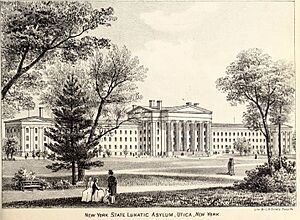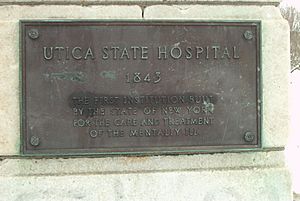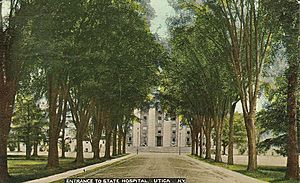Utica Psychiatric Center facts for kids
|
Utica State Hospital, Main Building
|
|
 |
|
| Location | 1213 Court Street, Utica, New York 13502 |
|---|---|
| Built | 1843 |
| Architect | Capt. William Clarke, Andrew Jackson Downing |
| Architectural style | Greek Revival |
| NRHP reference No. | 71000548 |
Quick facts for kids Significant dates |
|
| Added to NRHP | October 26, 1971 |
| Designated NHL | July 30, 1989 |
The Utica Psychiatric Center, also known as Utica State Hospital, opened in Utica on January 16, 1843. It was the first hospital in New York run by the state to care for people with mental illness. It was also one of the first of its kind in the United States.
The hospital's original name was the New York State Lunatic Asylum at Utica. The term "lunatic asylum" was a common name for mental health hospitals in the 1800s. The main building was designed in the Greek Revival style, which was inspired by ancient Greek temples. Its construction was paid for by the state and by people living in Utica.
In 1977, the hospital closed, and its last patients were moved to other facilities. Today, the main building is used to store records for the New York State Office of Mental Health. Because of its historical importance, it became a National Historic Landmark in 1989.
Contents
History of the Hospital
The New York government approved the hospital's creation in 1836. The first plan was to build four large buildings in a square. However, they only had enough money to build one. This first building is called "Old Main."
"Old Main" is a very large building. It is over 50 feet (15 m) high and 550 feet (170 m) long. The front of the building has six huge columns in the Greek style. Each column is 48 feet (15 m) tall and has a diameter of eight-foot (2.4 m).
A New Approach to Treatment
The hospital filled up quickly after it opened. To make more space, wings were added to each end of "Old Main" in 1846. By 1850, the hospital had 380 single rooms for patients, plus many other rooms like dormitories, dining rooms, and parlors.
The hospital's first director, Dr. Amariah Brigham, had new ideas about how to help patients. He believed that a good environment could help people get better. He gave patients large rooms, healthy food, and chances for exercise and learning.
Dr. Brigham also believed that work was a good form of therapy. Patients were encouraged to do outdoor tasks like gardening. They also learned crafts like needlework and carpentry. The hospital even held a fair every year to sell things the patients made. The money raised was used to buy books, musical instruments, and a greenhouse. Patients also created their own newspaper called The Opal, which was published from 1851 to 1860.
Challenges and Changes
In 1852, a fire broke out in the main building's stairway. Everyone was evacuated safely, but a firefighter and a doctor died trying to save items from the fire. The entire center of the building was destroyed. A few days later, another fire started in a barn on the hospital grounds. A former patient later admitted to starting both fires because he was upset with his boss.
A book published in 1890, called A Secret Institution, tells the story of Clarissa Caldwell Lathrop. She wrote about her time as a patient at the hospital after she told people she thought someone was trying to poison her.
A Journal for Mental Health
In 1844, Dr. Brigham started the American Journal of Insanity. It was the first journal in English written just about mental illness. The journal was printed right at the hospital.
After Dr. Brigham passed away, the hospital owned the journal. In 1894, the American Psychiatric Association bought it. The journal was later renamed the American Psychiatric Journal and is still published today.
The Utica Crib
Dr. Brigham did not like using chains to restrain patients who were out of control, which was a common practice at the time. He invented a special bed called the "Utica crib" as a different option. It was a bed with a thick mattress, high slatted sides, and a top that could be locked.
The crib was meant to help calm patients and keep them safe. Some patients said the crib helped them rest and feel better. However, its use was controversial. Some doctors criticized it, saying it was not helpful and could be dangerous. They compared it to a coffin. In 1887, a new director named George Alder Blumer had all the Utica cribs removed from the hospital.
Notable People
Some well-known people were connected to the hospital during its history.
Staff
- Edward Nathaniel Brush
- John P. Gray
Patients
- Clarissa Caldwell Lathrop (1880–1882)
- James Bailey Silkman (1882)
- Gerrit Smith (1860)
Photos














